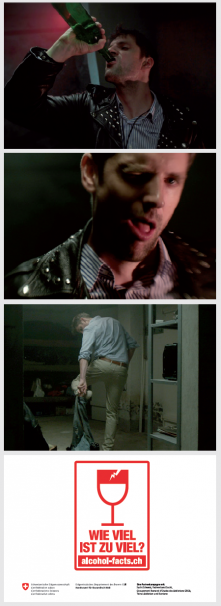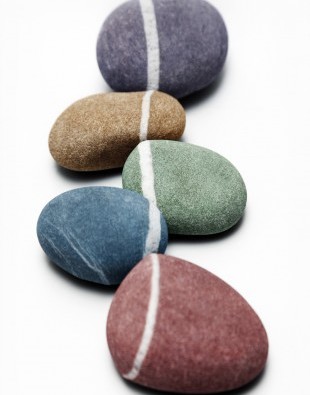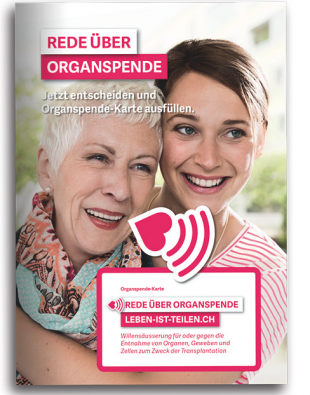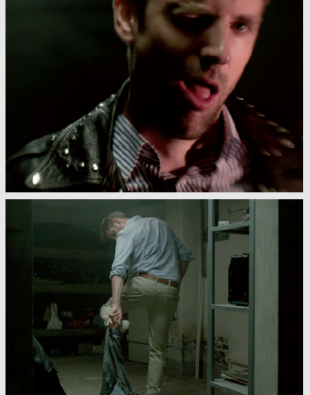
Alcohol: how much is too much?
Sep. 2016Life-course
Alcohol prevention campaign. We all know it: drinking too much alcohol is harmful. But at what point exactly does relaxed turn into careless, tipsiness into drunkenness, flirtation into harassment? In brief: how much is too much? The current campaign by the Federal Office of Public Health and its partners sets out to persuade people living in Switzerland to find the answer to this question for themselves. The second wave of the campaign is scheduled to start this September.
Sabine, 41, is invited to a meal with friends. She's looking forward to a relaxed evening with retellings of old stories. As usual in their group, all the guests bring a bottle of wine. The evening gets off to good start: people are getting into the mood and the noise level is rising. Sabine is sitting next to Paul. They talk animatedly about the football World Cup final, which Sabine believes was undeservedly won by the wrong side. She defends "her" team vigorously, blames the incompetent referee and, ultimately, Paul, who is slightly bothered by the passion and vehemence with which his friend presents her case. She sets about recreating the decisive penalty – and proving she is right – using wineglasses, the bread basket and a ball of ice cream that is still in its dish. As she leaps to her feet dramatically, she is overcome by the effect of the wine and bumps against the Monet reproduction that is hanging on the wall behind her. She is just able to grab it in time, and bursts into raucous laughter, causing all her friends to turn round and look at her. Great – now everyone can see what exactly happened with the penalty. She smashes the ice cream between the wineglass goalposts right onto Paul's white shirt: "Gooooal!" Paul is not amused by the performance. He goes off to look for a napkin – and for someone else to talk too – someone with whom he can still have a sensible conversation.
As the alcohol level rises, so do feelings of self-worth
Alcohol can reduce inhibition: blood alcohol levels of 0.05 percent or over cause euphoria. This means that up to a certain point, a rise in alcohol levels is matched by a rise in people's feelings of self-worth and in their assessment of their own abilities; they feel more confident, stronger and merrier. They make decisions on a less reasonable basis. In fact, they select the bolder, more unusual option that they would not go for if they were sober. They are relaxed and uninhibited. But if they go on drinking, some of them become talkative, boisterous and affectionate, while others turn aggressive and violent and sometimes overestimate their own abilities. Third parties suffer as a result.
Tempting for the young and the shy
The euphoric effect of alcohol is very attractive, particularly for young people. After drinking alcohol, they not only feel more sure of themselves, they also feel more accepted and more a part of their group, which is very important at this age. And they go on drinking in order to hold on to this feeling. The same applies to people who are very shy or suffer from social anxiety. They find interaction with other people much easier when they are under the influence of alcohol. If shy people feel self-confident and strong only when they have had a few drinks, they are at risk of becoming dependent on alcohol.
Elation gives way to despair
The enjoyable effects of alcohol fade rapidly. As more is consumed, negative emotions and inappropriate behaviour occur. The effects also depend on the drinker's current state of mind. If they have been sad or angry beforehand, an alcoholic drink can improve their mood. Alternatively, their mood plummets and they become even sadder or angrier. In addition, alcohol consumption can have immediate consequences such as accidents, injuries or unprotected sexual relations. Memory loss or complete blackouts are often not recognised until the next day, when it is already too late to stop the embarrassing mobile-phone films that are being passed around.
2nd wave of alcohol prevention campaign
The latest wave of the alcohol prevention campaign, "How much is too much?" seeks to sensitise the public to the downside of alcohol consumption and to inform it on the associated risks and dangers. The www.alcohol-facts.ch website continues to be the main medium for information on the campaign and for a concise overview of alcohol-related know-how and for advice and assistance services. It also offers a graphically amusing quiz that serves as a portal to detailed information on topics such as health-related risks, weight gain or the effects of alcohol on both body and mind. The current wave is scheduled to start in the first half of September and will kick off with a newly produced film.
Campaign film on the lure of alcohol
The new campaign film deals with the temptation to use alcohol in order to feel liberated and truly cool at long last. For many – especially younger – people, this is why they drink ever greater amounts of alcohol. At such moments, health risks and the possibility of accidents are rated as less important. The aim of the film is to motivate people to reflect on their behaviour when they have had a few drinks. For instance, what effect does alcohol have on me? Do I notice when my behaviour becomes embarrassing, careless or a risk to myself and to others? How much is too much for me? The film is available on the campaign website and can easily be forwarded to other people.
The next "Alcohol Dialogue Week" will be held throughout Switzerland from 11–21 May 2017.
Recommendations for low-risk alcohol consumption
– Men: 2–3 standard glasses* a day, at
least 2 no-alcohol days a week
– Women: 1–2 standard glasses* a day, at
least 2 no-alcohol days a week
– Under sixteens, pregnant women and
breast-feeding mothers: no alcohol
* One "standard" glass contains, for instance, 300 ml of beer or 100 ml of wine.




